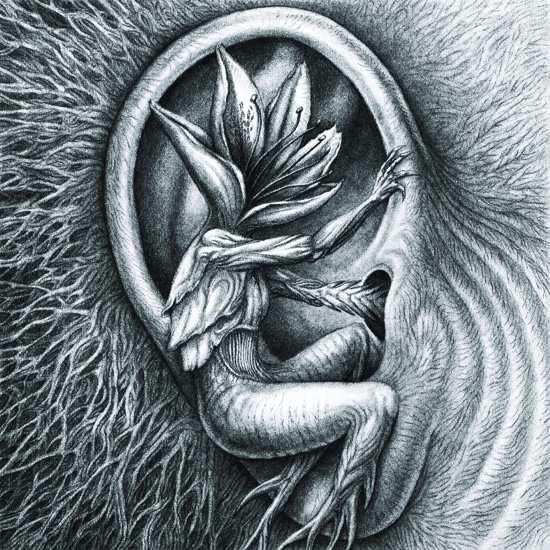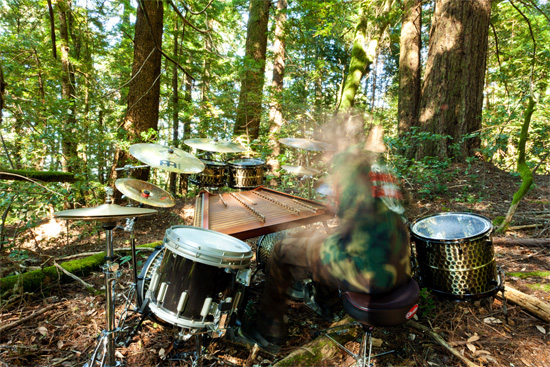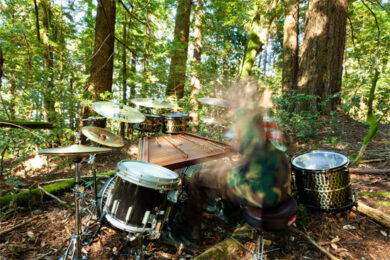Few genres are at war with themselves quite like black metal. Casually browse a forum or leaf through the letters page of a magazine and you’ll find the minutes of an ongoing McCarthyite purge to rid the genre of foul, creeping hipster influence and reinstate an orthodoxy of ‘kult’ behavior (which means, generally, doing it rather a lot like the Norwegians used to).
Curiously, though, for all this conflict black metal remains a heterodoxy, a fertile garden blooming with stark and unusual mutations. One such group is The Botanist, the current "eco-terrorist" solo project by Otrebor, a San Franciscan musician with history in the groups Ophidian Forest and Rubicon. The Botanist received a flurry of interest late last year when Brandon Stosuy discussed double album collection I: The Suicide Tree/II: A Rose From the Dead in his end-of-year metal chart for Pitchfork, noting it outside the Top 40 rundown because it "doesn’t seem to conform to a list’s hierarchy". Stosuy had a point. Because while there are familiar black metal antecedents to The Botanist’s sound – Otrebor’s anguished croak and the project’s general hermetic weirdness recalls something of the depressive/loner vibe of Striborg, Xasthur, et al – the instrumentation employed here takes it something firmly other. Played entirely on drums and hammered dulcimer, I: The Suicide Tree/II: A Rose From the Dead spins an acoustic black metal of shrill, alien tonality and winding, baroque complexity.
Meanwhile, the lyrics, rendered in the packaging in florid print, explore a complex eschatology, with references to ‘Mandrake legions’ and the apocalyptic ‘budding dawn’ articulating visions of a vengeful natural world set in revolt against humanity. Thematically, the project reminds me a little of Brian Aldiss’ 1962 sci-fi novel Hothouse, the tale of a band of mongrelised humanoids struggling to survive in a overgrown world where plant-life stretches into the planet’s atmosphere, the vegetable has turned predator, and humanity has been driven to the brink of extinction. Otrebor, however, refutes the idea that science fiction might have been an inspiration, preferring to root his project in more spiritual concerns.
Whatever its provenance, this is strange and uneasy music, seldom viscerally satisfying, but evocative in its apocalyptic visions of a world ruled by the plant. As Otrebor put the finishing touches to new Botanist material, the Quietus communicated with him by email.
Where and when did the Botanist project begin?
Otrebor: The proper recording for Botanist began in the fall of 2009, with the drums for I: The Suicide Tree and then II: A Rose From the Dead. The beginnings of the ideological concept for Botanist as a band started a year or so beforehand, but of the few people I tried to get interested in it, none really were. So I did it myself.
What is the attraction in recording as a one-man band?
O: Why record as a one-man band? Think of it like wanting to make a painting and having to wait on the realities of four other people to complete it. Going it alone allows for the removal of whatever conceivable obstacles other people could pose. Like a chain being only as strong as its weakest link, a band can move only so fast as its slowest member.
I’d like to talk about perhaps the most surprising facet of Botanist, the hammered dulcimer. It’s far from a typical black metal instrument. Where did you get it from, and was it difficult to learn to play?
O: Like any musical instrument that involves hitting things in time with stick-like objects, the hammered dulcimer is eminently intuitive to a drummer. Beyond that basic premise, is it hard to play? Sure, especially if one’s scope of hitting something with a stick goes from a surface area in which ten inches is an acceptable margin of error to one in which any more than three quarters of an inch is total disaster.
Botanist’s hammered dulcimer was made by James Jones, a manufacturer of folky instruments in West Virginia. Botanist’s is a used version of the grand piano of hammered dulcimers, what’s called a 7/19/18/9. I have a pet theory James was as excited to get rid of it as I was to get it. No matter what gets played on it, the result is eerie and foreboding. I believe the instrument to be possessed. This was not the case with the smaller dulcimer that I had before. That one sounded sweet and dainty in comparison. This one is perfect.
It’s an interesting choice of instrument in that it’s both melodic and percussive. Do you play it ‘classically’, or are you self-taught? Is it easy to play simultaneously with drums?
O: There are some elements rooted in established musical theory that make their way into how Botanist songs get written. But really, it’s more a question of summoning. When Botanist music gets recorded, I channel an entity within me that’s been named ‘The Botanist’, a character whose perspective dictates the content of the music and lyrics. In some sense, The Botanist plays through me. When you read an interview with Botanist, you get it with me, Otrebor. The Botanist does not speak in these situations, as he would not have anything to do with humanity. The Botanist speaks only through the music and lyrics.
My approach to playing music, as can especially be seen on the first couple albums, is playing as close to the edge of my ability as I can. The conceptualisation of ‘metalness’ appeals to me, as it’s like lifting maximum weight over your head: on any given attempt, you might not make it, even if you try your hardest. You can hear the warts in my playing on the records. Fixing these issues, with digital aids, for example, would be disrespectful to how the weight could come crashing down on your head at any moment.
Can you outline your vision, ecologically speaking? Do you subscribe to any ecological theories – ie Gaia theory, deep ecology, the "eco terrorist" writing of the likes of Ted Kaczynski? Have you had any ties with any environmental action groups – Greenpeace, Earth First, etc? Or do you take a more figurative or spiritual approach?
O: It’s been remarkable how much of a hook that "eco-terrorist" tag has been, and how the term triggers inquiries to political associations. In Botanist’s world, that descriptor is not necessarily defined by its popular perception – namely, that of people acting as the agents of terror for naturalistic causes. Rather, the term "eco-terrorist" used here regards nature itself as the agent of terror against the human oppressor, and more specifically a representation of how The Botanist, in his particular worldview, sees nature as playing this role. In the mythology of The Verdant Realm, there is no political affiliation, as choosing a political side is about choosing the interests of one group of people over another. In the romantic worldview in which plants reclaim the earth after humanity has killed itself, surely there is no possibility of political alignment.
The dominant, capitalistic global culture essentially sees nature as a resource to be exploited or plundered in the pursuit of profit. Have we lost something important in our relationship with the natural world?
O: Unfortunately for the natural world, the issue of saving the environment is primarily the concern of a portion of the middle class in first world nations, which is very nice when all the lefties in San Francisco or New York are making sure their compostable garbage is in a special biodegradable bag, or when youth hostels make you pay for your contribution to ‘CO2 emissions,’ but the rest of the planet’s human population, the vast, vast majority, is made up of a) people too poor to know, care, or be able to do something about deforestation or the ozone layer, and b) those of immense wealth who enable those with none to continue to be unable to do anything.
Even though green is a hip trend in the USA, major green initiatives keep getting voted down. It will continue to happen until the shift can go from saving the whales for the whales’ sake to saving the whales for the sake of the quality of life and the state of the wallets of those voting. When the environment becomes an economic issue rather than a moral one, change will be made.
Fortunately for the natural world, even if humanity nukes the planet 800 times over and destroys every living thing on it, nature will bounce back eventually and carry on as it always has. Mankind cannot ruin nature. It can only ruin it for itself.

Cover art for III: Doom In Bloom, by M.S. Waldron
Have you played live often? Is Botanist something that can exist on more conventional black metal bills, or does it seem to fit outside of that?
O: Based on the response from the press, and the interest in sources that do not solely cater to a metal audience, it seems possible that Botanist could also reach beyond a black metal bill, but it would be presumptuous of me to predict it as one way or another. It might be equally as presumptuous to believe that a black metal bill would even want Botanist on it. But the genre is increasingly producing bands that the contemporary art and subcultural world at large seriously considers for its artistic merit, and progressively less as a sideshow, as it initially was mostly.
Although I have played live and toured with a past band, Botanist has never played live. Prior to July of 2011, no one outside the circle of [tUMULt label boss] Andee Connors, the guy who did the post-production on the albums, and like 10 other people – eight of whom were too bewildered (or maybe polite) to be able to say whether they liked it or not – even knew about the band. It’s kind of a medium-term goal to get a live line-up together to further promote the project. What is needed is at least two people to play dulcimer. Interested parties, contact me. If you can hit things accurately and in time with sticks or mallets, you can play dulcimer in Botanist. You’d need to get your own instruments. I can guarantee you shows and tours, based on the amount of out-of-state booking agents that contact me inviting me to come play. I’m serious.
Reading the lyric sheet, there appears to be a fairly sophisticated mythology at work, with talk of ‘The Verdant Realm’, ‘The Chlorophyllic Continuum’, ‘The Mandrake Legion’… are these entirely of your own invention, or have you based aspects of the lyrical content on existing beliefs or mythology?
O: Those concepts, which will be further developed on forthcoming albums, are products of my imagination. Of course, I didn’t invent the mythology of the Mandrake, or any of the plants detailed in the lyrics, but the alchemical method of a Mandrake’s creation and nature is something that was adapted in the lore of Botanist… and is the focal point of Botanist’s IV: Mandragora, slated to be released by ever-growing label The Flenser in August of 2012. You can read more about those concepts in the Lore section of the Botanist website.
Your two albums so far have been compiled as I: The Suicide Tree/II: A Rose From The Dead. Do you feel the two differ musically/thematically? Is there a third album on the way, and do you have anything particular in mind?
O: As the two were mixed in different sessions, there are some slight differences in sound, like how we blended the acoustic and distorted tone of the dulcimers, and used an octave pedal that only kicks in when the pitches got low enough. Also, the vocals are mixed in better on II. Despite these minor flavour differences, the two first efforts go well together on one release as they are practically cut from the same cloth. For a more sizable progression, wait for III: Doom In Bloom, due April 2012 on TotalRust. Expect long songs, slow tempos, big, crushing drums, and expanded instrumentation. It sounds what you’d expect from a doom album version of the first couple Botanist albums. It’s going to be another double disc, except this time the second disc won’t be Botanist, per se, but rather friends of Botanist making music of their choosing to drums from the III drum sessions, with the sole limitation that each song be somehow about plants or nature. It might give you some insights into alternate botanical universes. The cover art was done by the American artist M.S. Waldron, who also plays in the experimental group irr. app. (ext.)). He’s like the H.R. Giger of plants.
There still seems to be a sizeable resistance, particularly in (but by no means isolated to) the US, towards notions of climate change. Even if we can resist the effects of a warming planet, we face a future characterised by resource depletion and overpopulation. Is humanity doomed? Is there salvation for us?
Humanity is doomed. And The Botanist awaits that doom eagerly.



